Book Review: Viola Desmond’s Canada
VerifiedAdded on 2023/06/10
|7
|1881
|150
AI Summary
This book review discusses the history of anti-Black racism in Canada as presented in Viola Desmond’s Canada by Reynolds. The author argues that the history of African Canadians remains a marginalized field in the country’s history. Reynolds’ account of the Black Canadian experience is not reliable as it only discusses the life of the Blacks in Nova Scotia while paying minimal attention to related accounts in other parts including Ontario, Quebec and New France.
Contribute Materials
Your contribution can guide someone’s learning journey. Share your
documents today.
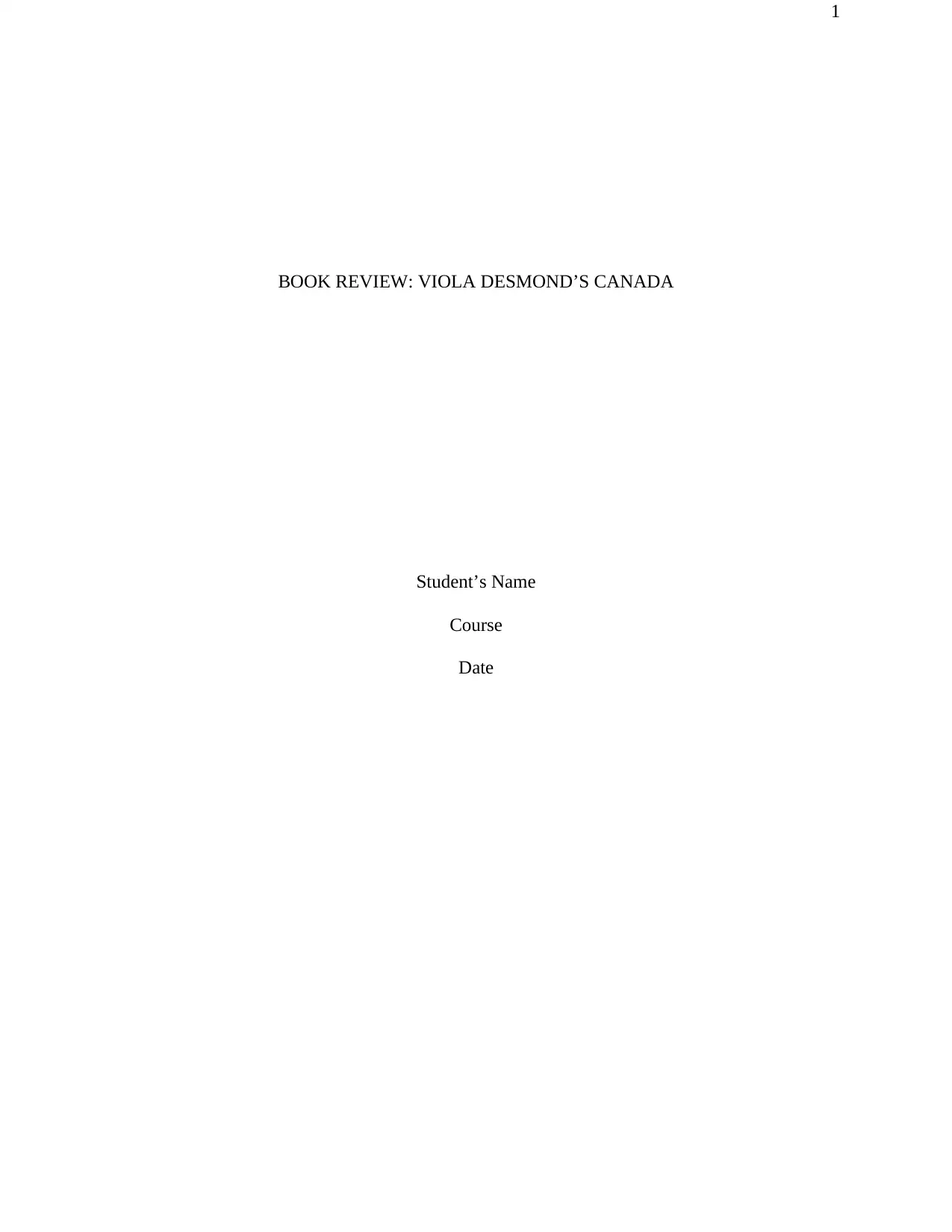
1
BOOK REVIEW: VIOLA DESMOND’S CANADA
Student’s Name
Course
Date
BOOK REVIEW: VIOLA DESMOND’S CANADA
Student’s Name
Course
Date
Secure Best Marks with AI Grader
Need help grading? Try our AI Grader for instant feedback on your assignments.
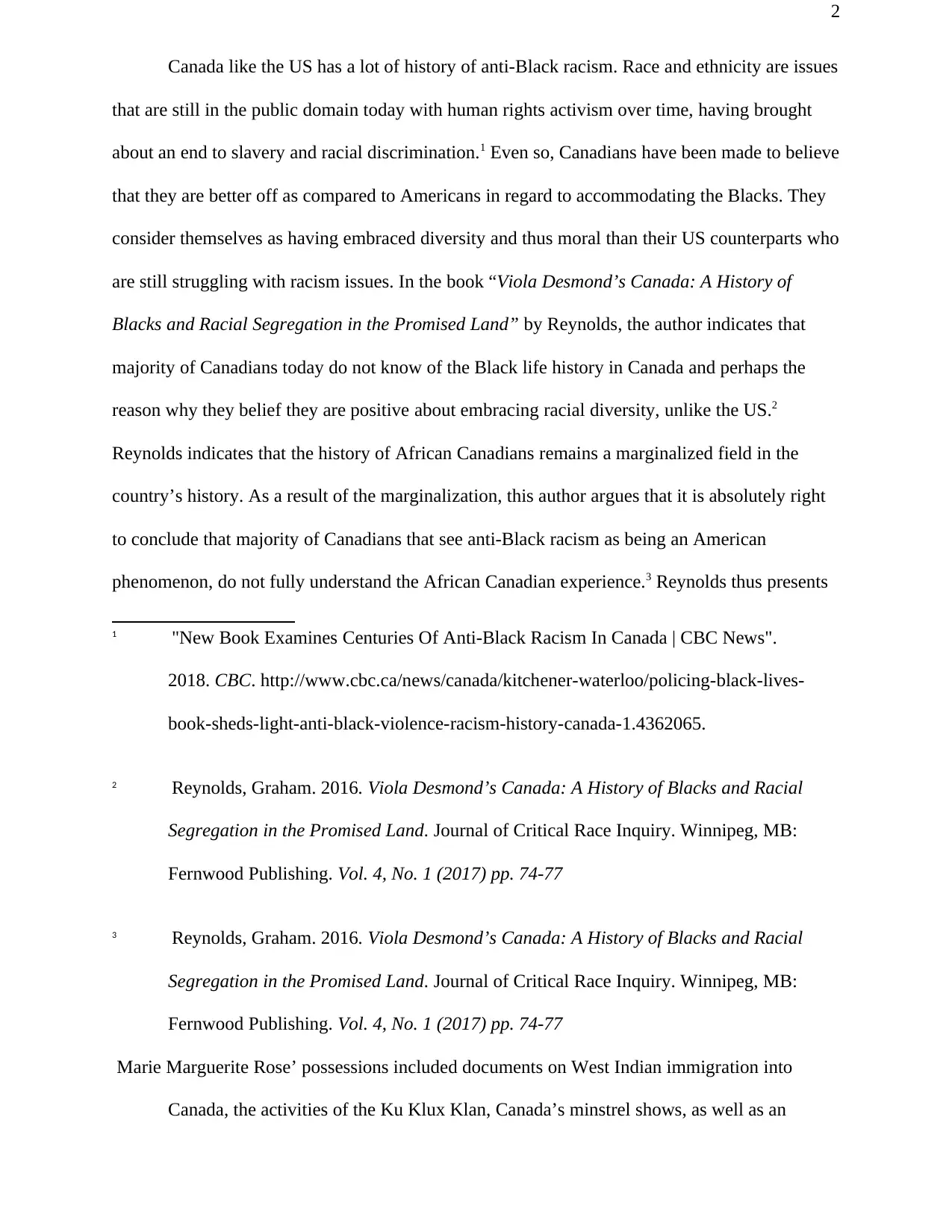
2
Canada like the US has a lot of history of anti-Black racism. Race and ethnicity are issues
that are still in the public domain today with human rights activism over time, having brought
about an end to slavery and racial discrimination.1 Even so, Canadians have been made to believe
that they are better off as compared to Americans in regard to accommodating the Blacks. They
consider themselves as having embraced diversity and thus moral than their US counterparts who
are still struggling with racism issues. In the book “Viola Desmond’s Canada: A History of
Blacks and Racial Segregation in the Promised Land” by Reynolds, the author indicates that
majority of Canadians today do not know of the Black life history in Canada and perhaps the
reason why they belief they are positive about embracing racial diversity, unlike the US.2
Reynolds indicates that the history of African Canadians remains a marginalized field in the
country’s history. As a result of the marginalization, this author argues that it is absolutely right
to conclude that majority of Canadians that see anti-Black racism as being an American
phenomenon, do not fully understand the African Canadian experience.3 Reynolds thus presents
1 "New Book Examines Centuries Of Anti-Black Racism In Canada | CBC News".
2018. CBC. http://www.cbc.ca/news/canada/kitchener-waterloo/policing-black-lives-
book-sheds-light-anti-black-violence-racism-history-canada-1.4362065.
2 Reynolds, Graham. 2016. Viola Desmond’s Canada: A History of Blacks and Racial
Segregation in the Promised Land. Journal of Critical Race Inquiry. Winnipeg, MB:
Fernwood Publishing. Vol. 4, No. 1 (2017) pp. 74-77
3 Reynolds, Graham. 2016. Viola Desmond’s Canada: A History of Blacks and Racial
Segregation in the Promised Land. Journal of Critical Race Inquiry. Winnipeg, MB:
Fernwood Publishing. Vol. 4, No. 1 (2017) pp. 74-77
Marie Marguerite Rose’ possessions included documents on West Indian immigration into
Canada, the activities of the Ku Klux Klan, Canada’s minstrel shows, as well as an
Canada like the US has a lot of history of anti-Black racism. Race and ethnicity are issues
that are still in the public domain today with human rights activism over time, having brought
about an end to slavery and racial discrimination.1 Even so, Canadians have been made to believe
that they are better off as compared to Americans in regard to accommodating the Blacks. They
consider themselves as having embraced diversity and thus moral than their US counterparts who
are still struggling with racism issues. In the book “Viola Desmond’s Canada: A History of
Blacks and Racial Segregation in the Promised Land” by Reynolds, the author indicates that
majority of Canadians today do not know of the Black life history in Canada and perhaps the
reason why they belief they are positive about embracing racial diversity, unlike the US.2
Reynolds indicates that the history of African Canadians remains a marginalized field in the
country’s history. As a result of the marginalization, this author argues that it is absolutely right
to conclude that majority of Canadians that see anti-Black racism as being an American
phenomenon, do not fully understand the African Canadian experience.3 Reynolds thus presents
1 "New Book Examines Centuries Of Anti-Black Racism In Canada | CBC News".
2018. CBC. http://www.cbc.ca/news/canada/kitchener-waterloo/policing-black-lives-
book-sheds-light-anti-black-violence-racism-history-canada-1.4362065.
2 Reynolds, Graham. 2016. Viola Desmond’s Canada: A History of Blacks and Racial
Segregation in the Promised Land. Journal of Critical Race Inquiry. Winnipeg, MB:
Fernwood Publishing. Vol. 4, No. 1 (2017) pp. 74-77
3 Reynolds, Graham. 2016. Viola Desmond’s Canada: A History of Blacks and Racial
Segregation in the Promised Land. Journal of Critical Race Inquiry. Winnipeg, MB:
Fernwood Publishing. Vol. 4, No. 1 (2017) pp. 74-77
Marie Marguerite Rose’ possessions included documents on West Indian immigration into
Canada, the activities of the Ku Klux Klan, Canada’s minstrel shows, as well as an
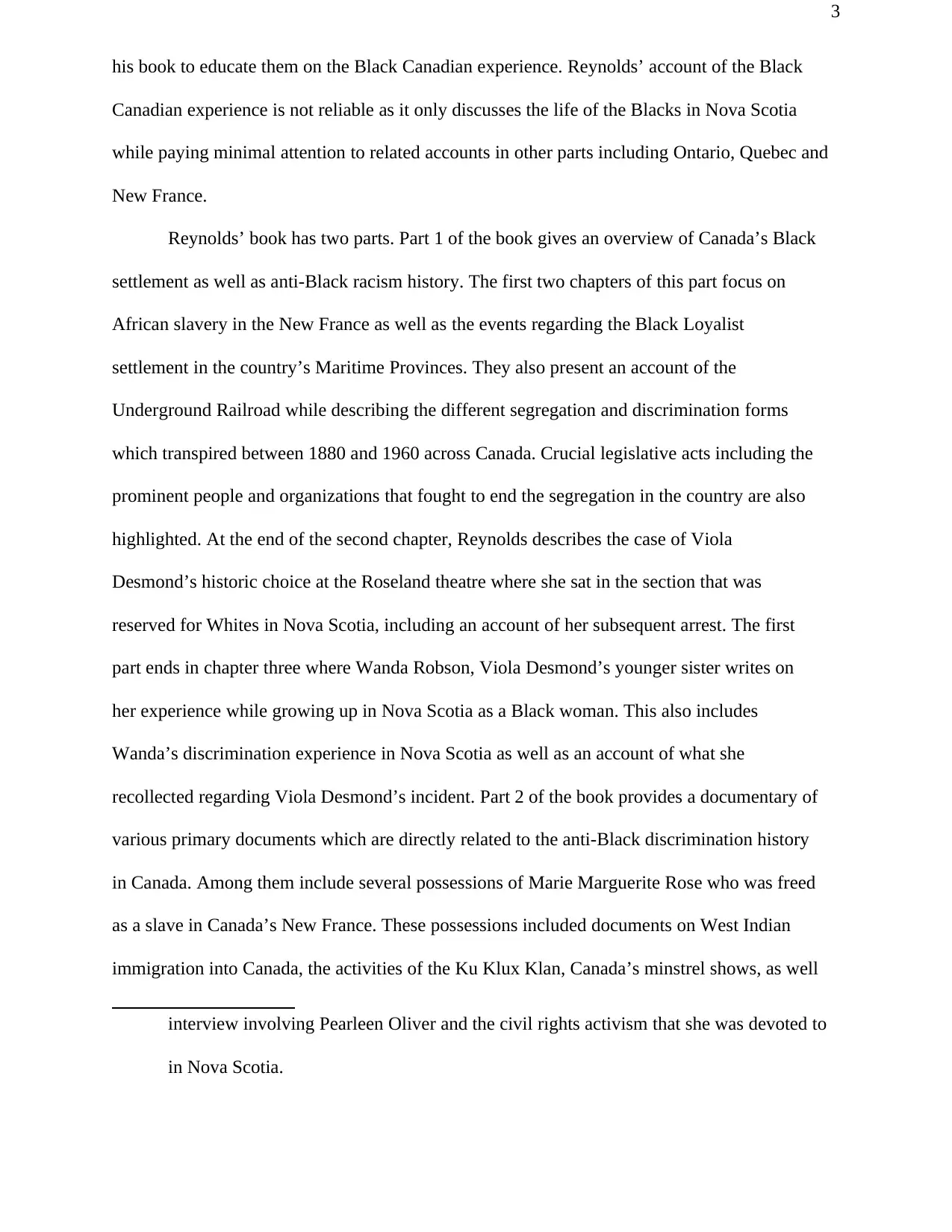
3
his book to educate them on the Black Canadian experience. Reynolds’ account of the Black
Canadian experience is not reliable as it only discusses the life of the Blacks in Nova Scotia
while paying minimal attention to related accounts in other parts including Ontario, Quebec and
New France.
Reynolds’ book has two parts. Part 1 of the book gives an overview of Canada’s Black
settlement as well as anti-Black racism history. The first two chapters of this part focus on
African slavery in the New France as well as the events regarding the Black Loyalist
settlement in the country’s Maritime Provinces. They also present an account of the
Underground Railroad while describing the different segregation and discrimination forms
which transpired between 1880 and 1960 across Canada. Crucial legislative acts including the
prominent people and organizations that fought to end the segregation in the country are also
highlighted. At the end of the second chapter, Reynolds describes the case of Viola
Desmond’s historic choice at the Roseland theatre where she sat in the section that was
reserved for Whites in Nova Scotia, including an account of her subsequent arrest. The first
part ends in chapter three where Wanda Robson, Viola Desmond’s younger sister writes on
her experience while growing up in Nova Scotia as a Black woman. This also includes
Wanda’s discrimination experience in Nova Scotia as well as an account of what she
recollected regarding Viola Desmond’s incident. Part 2 of the book provides a documentary of
various primary documents which are directly related to the anti-Black discrimination history
in Canada. Among them include several possessions of Marie Marguerite Rose who was freed
as a slave in Canada’s New France. These possessions included documents on West Indian
immigration into Canada, the activities of the Ku Klux Klan, Canada’s minstrel shows, as well
interview involving Pearleen Oliver and the civil rights activism that she was devoted to
in Nova Scotia.
his book to educate them on the Black Canadian experience. Reynolds’ account of the Black
Canadian experience is not reliable as it only discusses the life of the Blacks in Nova Scotia
while paying minimal attention to related accounts in other parts including Ontario, Quebec and
New France.
Reynolds’ book has two parts. Part 1 of the book gives an overview of Canada’s Black
settlement as well as anti-Black racism history. The first two chapters of this part focus on
African slavery in the New France as well as the events regarding the Black Loyalist
settlement in the country’s Maritime Provinces. They also present an account of the
Underground Railroad while describing the different segregation and discrimination forms
which transpired between 1880 and 1960 across Canada. Crucial legislative acts including the
prominent people and organizations that fought to end the segregation in the country are also
highlighted. At the end of the second chapter, Reynolds describes the case of Viola
Desmond’s historic choice at the Roseland theatre where she sat in the section that was
reserved for Whites in Nova Scotia, including an account of her subsequent arrest. The first
part ends in chapter three where Wanda Robson, Viola Desmond’s younger sister writes on
her experience while growing up in Nova Scotia as a Black woman. This also includes
Wanda’s discrimination experience in Nova Scotia as well as an account of what she
recollected regarding Viola Desmond’s incident. Part 2 of the book provides a documentary of
various primary documents which are directly related to the anti-Black discrimination history
in Canada. Among them include several possessions of Marie Marguerite Rose who was freed
as a slave in Canada’s New France. These possessions included documents on West Indian
immigration into Canada, the activities of the Ku Klux Klan, Canada’s minstrel shows, as well
interview involving Pearleen Oliver and the civil rights activism that she was devoted to
in Nova Scotia.
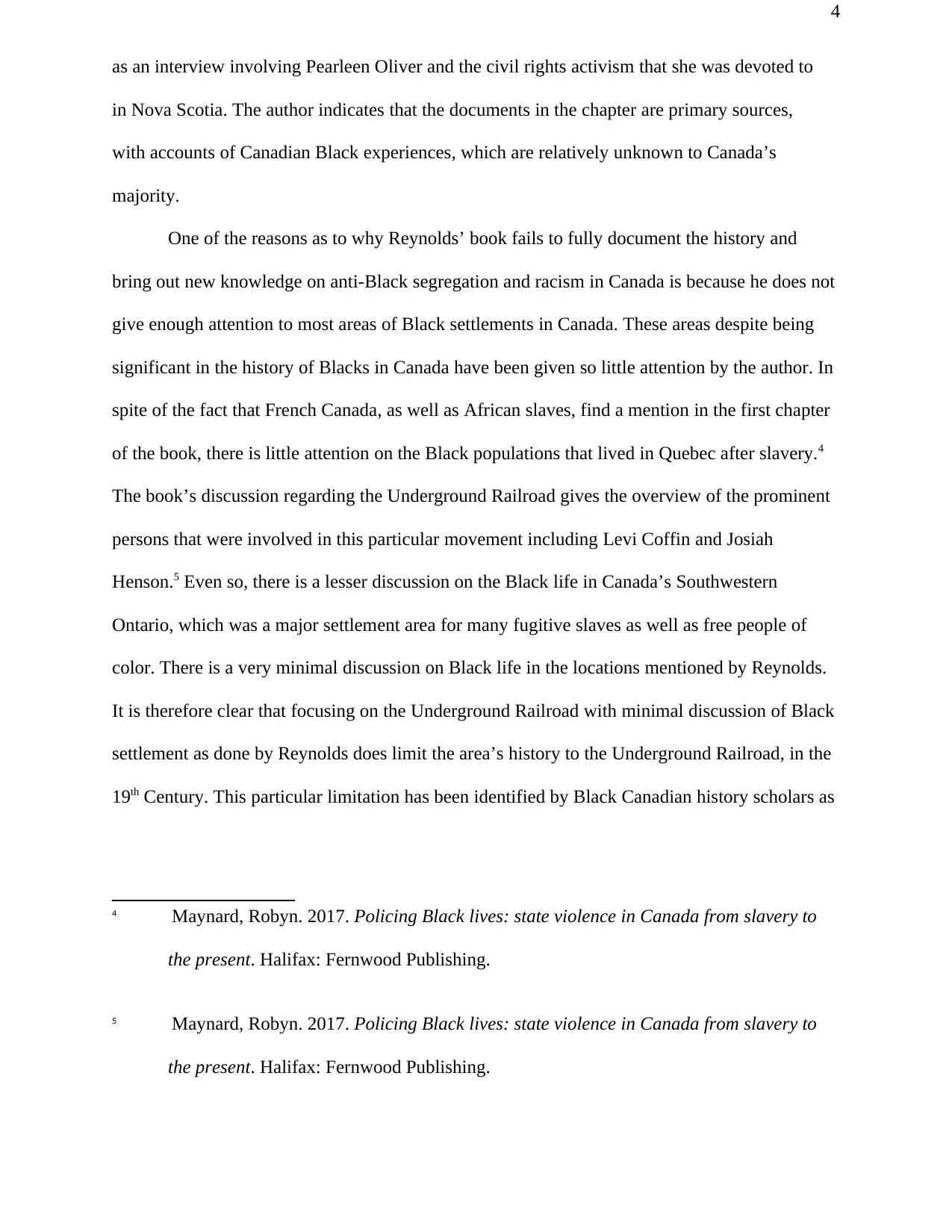
4
as an interview involving Pearleen Oliver and the civil rights activism that she was devoted to
in Nova Scotia. The author indicates that the documents in the chapter are primary sources,
with accounts of Canadian Black experiences, which are relatively unknown to Canada’s
majority.
One of the reasons as to why Reynolds’ book fails to fully document the history and
bring out new knowledge on anti-Black segregation and racism in Canada is because he does not
give enough attention to most areas of Black settlements in Canada. These areas despite being
significant in the history of Blacks in Canada have been given so little attention by the author. In
spite of the fact that French Canada, as well as African slaves, find a mention in the first chapter
of the book, there is little attention on the Black populations that lived in Quebec after slavery.4
The book’s discussion regarding the Underground Railroad gives the overview of the prominent
persons that were involved in this particular movement including Levi Coffin and Josiah
Henson.5 Even so, there is a lesser discussion on the Black life in Canada’s Southwestern
Ontario, which was a major settlement area for many fugitive slaves as well as free people of
color. There is a very minimal discussion on Black life in the locations mentioned by Reynolds.
It is therefore clear that focusing on the Underground Railroad with minimal discussion of Black
settlement as done by Reynolds does limit the area’s history to the Underground Railroad, in the
19th Century. This particular limitation has been identified by Black Canadian history scholars as
4 Maynard, Robyn. 2017. Policing Black lives: state violence in Canada from slavery to
the present. Halifax: Fernwood Publishing.
5 Maynard, Robyn. 2017. Policing Black lives: state violence in Canada from slavery to
the present. Halifax: Fernwood Publishing.
as an interview involving Pearleen Oliver and the civil rights activism that she was devoted to
in Nova Scotia. The author indicates that the documents in the chapter are primary sources,
with accounts of Canadian Black experiences, which are relatively unknown to Canada’s
majority.
One of the reasons as to why Reynolds’ book fails to fully document the history and
bring out new knowledge on anti-Black segregation and racism in Canada is because he does not
give enough attention to most areas of Black settlements in Canada. These areas despite being
significant in the history of Blacks in Canada have been given so little attention by the author. In
spite of the fact that French Canada, as well as African slaves, find a mention in the first chapter
of the book, there is little attention on the Black populations that lived in Quebec after slavery.4
The book’s discussion regarding the Underground Railroad gives the overview of the prominent
persons that were involved in this particular movement including Levi Coffin and Josiah
Henson.5 Even so, there is a lesser discussion on the Black life in Canada’s Southwestern
Ontario, which was a major settlement area for many fugitive slaves as well as free people of
color. There is a very minimal discussion on Black life in the locations mentioned by Reynolds.
It is therefore clear that focusing on the Underground Railroad with minimal discussion of Black
settlement as done by Reynolds does limit the area’s history to the Underground Railroad, in the
19th Century. This particular limitation has been identified by Black Canadian history scholars as
4 Maynard, Robyn. 2017. Policing Black lives: state violence in Canada from slavery to
the present. Halifax: Fernwood Publishing.
5 Maynard, Robyn. 2017. Policing Black lives: state violence in Canada from slavery to
the present. Halifax: Fernwood Publishing.
Secure Best Marks with AI Grader
Need help grading? Try our AI Grader for instant feedback on your assignments.
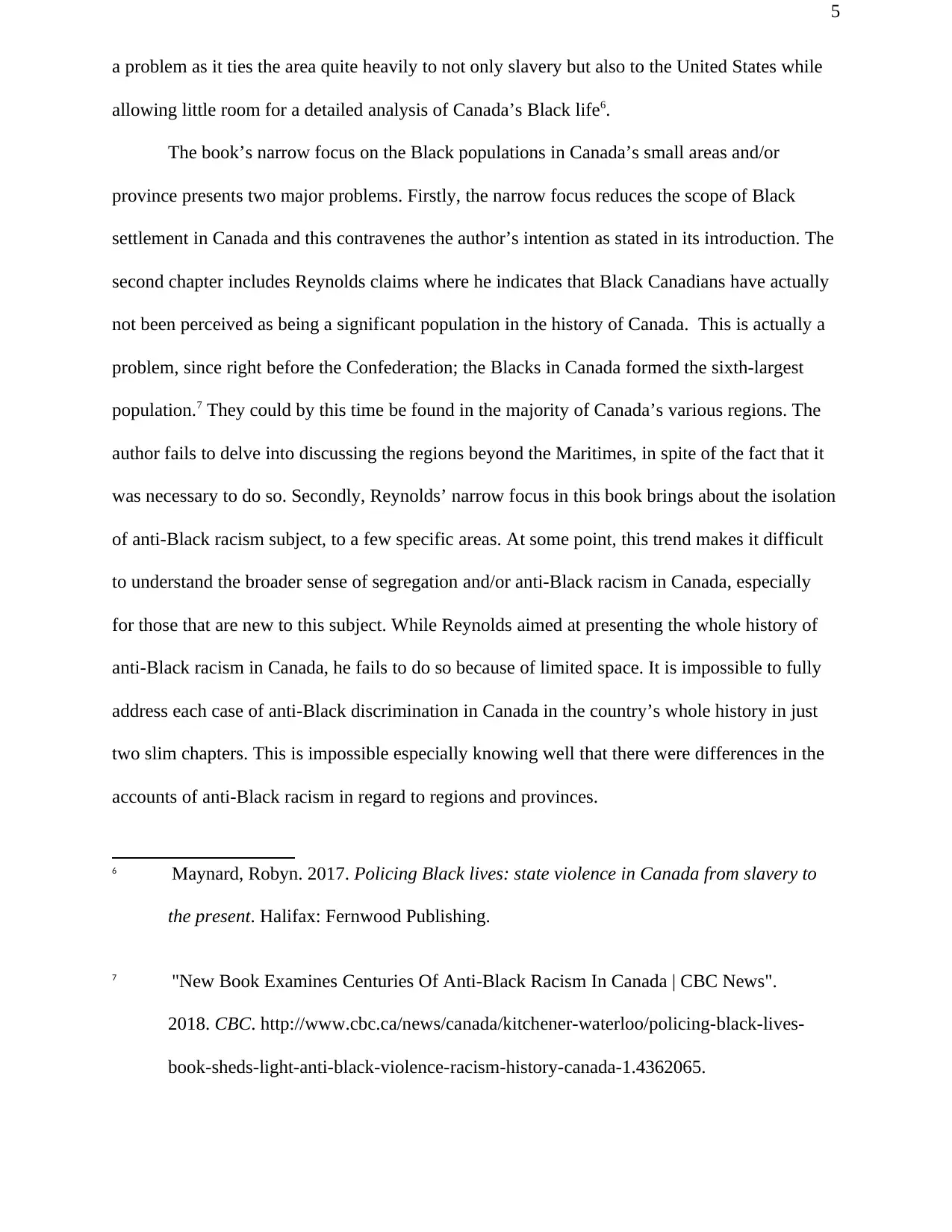
5
a problem as it ties the area quite heavily to not only slavery but also to the United States while
allowing little room for a detailed analysis of Canada’s Black life6.
The book’s narrow focus on the Black populations in Canada’s small areas and/or
province presents two major problems. Firstly, the narrow focus reduces the scope of Black
settlement in Canada and this contravenes the author’s intention as stated in its introduction. The
second chapter includes Reynolds claims where he indicates that Black Canadians have actually
not been perceived as being a significant population in the history of Canada. This is actually a
problem, since right before the Confederation; the Blacks in Canada formed the sixth-largest
population.7 They could by this time be found in the majority of Canada’s various regions. The
author fails to delve into discussing the regions beyond the Maritimes, in spite of the fact that it
was necessary to do so. Secondly, Reynolds’ narrow focus in this book brings about the isolation
of anti-Black racism subject, to a few specific areas. At some point, this trend makes it difficult
to understand the broader sense of segregation and/or anti-Black racism in Canada, especially
for those that are new to this subject. While Reynolds aimed at presenting the whole history of
anti-Black racism in Canada, he fails to do so because of limited space. It is impossible to fully
address each case of anti-Black discrimination in Canada in the country’s whole history in just
two slim chapters. This is impossible especially knowing well that there were differences in the
accounts of anti-Black racism in regard to regions and provinces.
6 Maynard, Robyn. 2017. Policing Black lives: state violence in Canada from slavery to
the present. Halifax: Fernwood Publishing.
7 "New Book Examines Centuries Of Anti-Black Racism In Canada | CBC News".
2018. CBC. http://www.cbc.ca/news/canada/kitchener-waterloo/policing-black-lives-
book-sheds-light-anti-black-violence-racism-history-canada-1.4362065.
a problem as it ties the area quite heavily to not only slavery but also to the United States while
allowing little room for a detailed analysis of Canada’s Black life6.
The book’s narrow focus on the Black populations in Canada’s small areas and/or
province presents two major problems. Firstly, the narrow focus reduces the scope of Black
settlement in Canada and this contravenes the author’s intention as stated in its introduction. The
second chapter includes Reynolds claims where he indicates that Black Canadians have actually
not been perceived as being a significant population in the history of Canada. This is actually a
problem, since right before the Confederation; the Blacks in Canada formed the sixth-largest
population.7 They could by this time be found in the majority of Canada’s various regions. The
author fails to delve into discussing the regions beyond the Maritimes, in spite of the fact that it
was necessary to do so. Secondly, Reynolds’ narrow focus in this book brings about the isolation
of anti-Black racism subject, to a few specific areas. At some point, this trend makes it difficult
to understand the broader sense of segregation and/or anti-Black racism in Canada, especially
for those that are new to this subject. While Reynolds aimed at presenting the whole history of
anti-Black racism in Canada, he fails to do so because of limited space. It is impossible to fully
address each case of anti-Black discrimination in Canada in the country’s whole history in just
two slim chapters. This is impossible especially knowing well that there were differences in the
accounts of anti-Black racism in regard to regions and provinces.
6 Maynard, Robyn. 2017. Policing Black lives: state violence in Canada from slavery to
the present. Halifax: Fernwood Publishing.
7 "New Book Examines Centuries Of Anti-Black Racism In Canada | CBC News".
2018. CBC. http://www.cbc.ca/news/canada/kitchener-waterloo/policing-black-lives-
book-sheds-light-anti-black-violence-racism-history-canada-1.4362065.
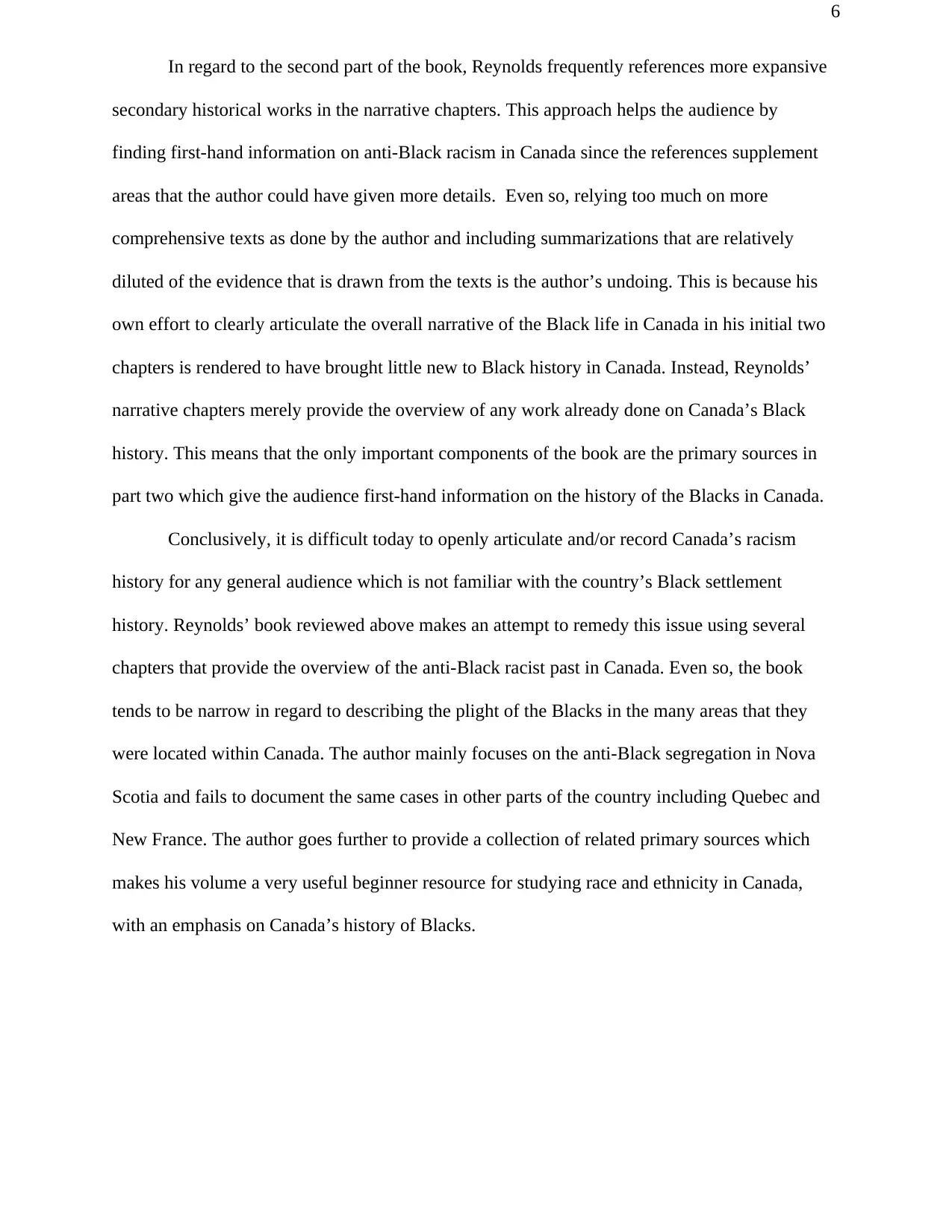
6
In regard to the second part of the book, Reynolds frequently references more expansive
secondary historical works in the narrative chapters. This approach helps the audience by
finding first-hand information on anti-Black racism in Canada since the references supplement
areas that the author could have given more details. Even so, relying too much on more
comprehensive texts as done by the author and including summarizations that are relatively
diluted of the evidence that is drawn from the texts is the author’s undoing. This is because his
own effort to clearly articulate the overall narrative of the Black life in Canada in his initial two
chapters is rendered to have brought little new to Black history in Canada. Instead, Reynolds’
narrative chapters merely provide the overview of any work already done on Canada’s Black
history. This means that the only important components of the book are the primary sources in
part two which give the audience first-hand information on the history of the Blacks in Canada.
Conclusively, it is difficult today to openly articulate and/or record Canada’s racism
history for any general audience which is not familiar with the country’s Black settlement
history. Reynolds’ book reviewed above makes an attempt to remedy this issue using several
chapters that provide the overview of the anti-Black racist past in Canada. Even so, the book
tends to be narrow in regard to describing the plight of the Blacks in the many areas that they
were located within Canada. The author mainly focuses on the anti-Black segregation in Nova
Scotia and fails to document the same cases in other parts of the country including Quebec and
New France. The author goes further to provide a collection of related primary sources which
makes his volume a very useful beginner resource for studying race and ethnicity in Canada,
with an emphasis on Canada’s history of Blacks.
In regard to the second part of the book, Reynolds frequently references more expansive
secondary historical works in the narrative chapters. This approach helps the audience by
finding first-hand information on anti-Black racism in Canada since the references supplement
areas that the author could have given more details. Even so, relying too much on more
comprehensive texts as done by the author and including summarizations that are relatively
diluted of the evidence that is drawn from the texts is the author’s undoing. This is because his
own effort to clearly articulate the overall narrative of the Black life in Canada in his initial two
chapters is rendered to have brought little new to Black history in Canada. Instead, Reynolds’
narrative chapters merely provide the overview of any work already done on Canada’s Black
history. This means that the only important components of the book are the primary sources in
part two which give the audience first-hand information on the history of the Blacks in Canada.
Conclusively, it is difficult today to openly articulate and/or record Canada’s racism
history for any general audience which is not familiar with the country’s Black settlement
history. Reynolds’ book reviewed above makes an attempt to remedy this issue using several
chapters that provide the overview of the anti-Black racist past in Canada. Even so, the book
tends to be narrow in regard to describing the plight of the Blacks in the many areas that they
were located within Canada. The author mainly focuses on the anti-Black segregation in Nova
Scotia and fails to document the same cases in other parts of the country including Quebec and
New France. The author goes further to provide a collection of related primary sources which
makes his volume a very useful beginner resource for studying race and ethnicity in Canada,
with an emphasis on Canada’s history of Blacks.
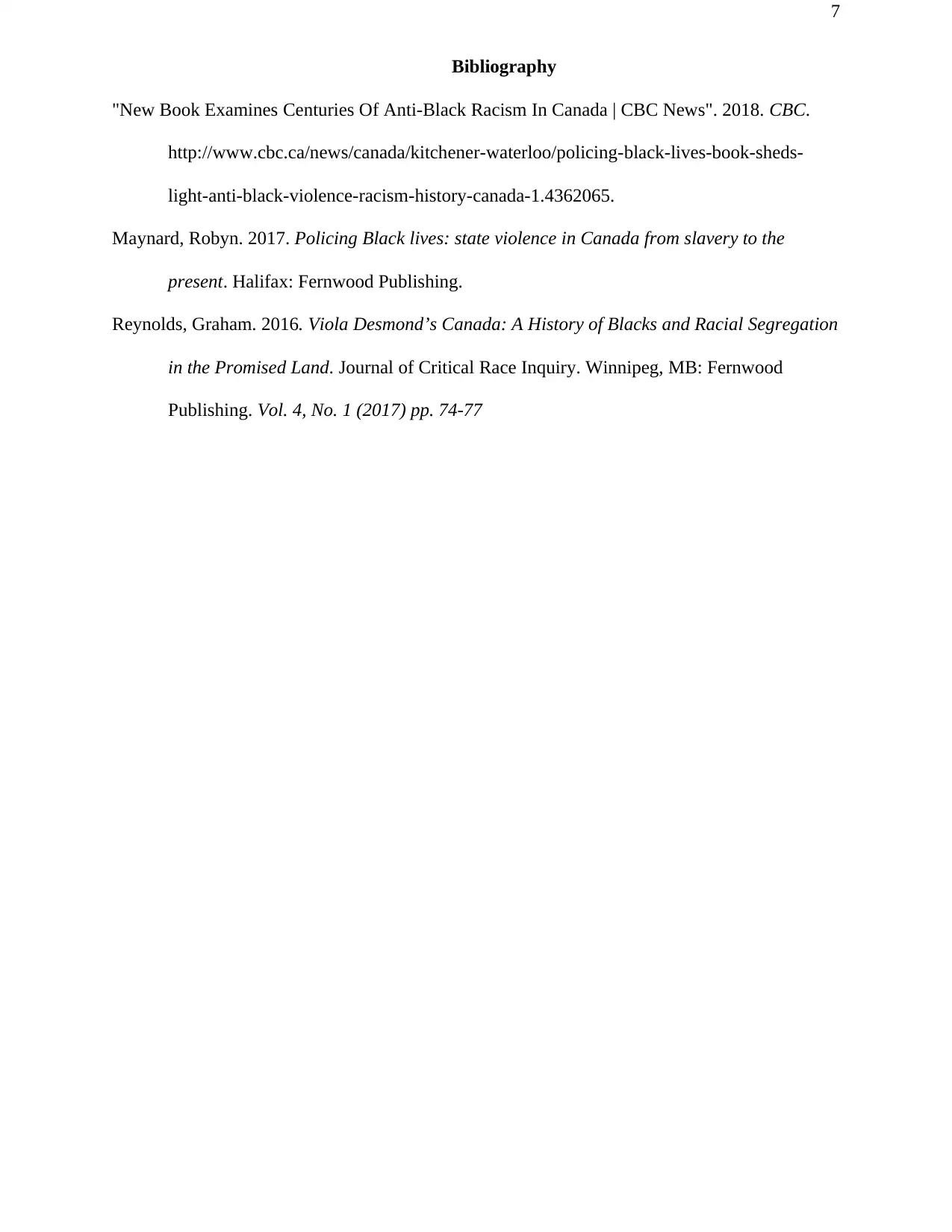
7
Bibliography
"New Book Examines Centuries Of Anti-Black Racism In Canada | CBC News". 2018. CBC.
http://www.cbc.ca/news/canada/kitchener-waterloo/policing-black-lives-book-sheds-
light-anti-black-violence-racism-history-canada-1.4362065.
Maynard, Robyn. 2017. Policing Black lives: state violence in Canada from slavery to the
present. Halifax: Fernwood Publishing.
Reynolds, Graham. 2016. Viola Desmond’s Canada: A History of Blacks and Racial Segregation
in the Promised Land. Journal of Critical Race Inquiry. Winnipeg, MB: Fernwood
Publishing. Vol. 4, No. 1 (2017) pp. 74-77
Bibliography
"New Book Examines Centuries Of Anti-Black Racism In Canada | CBC News". 2018. CBC.
http://www.cbc.ca/news/canada/kitchener-waterloo/policing-black-lives-book-sheds-
light-anti-black-violence-racism-history-canada-1.4362065.
Maynard, Robyn. 2017. Policing Black lives: state violence in Canada from slavery to the
present. Halifax: Fernwood Publishing.
Reynolds, Graham. 2016. Viola Desmond’s Canada: A History of Blacks and Racial Segregation
in the Promised Land. Journal of Critical Race Inquiry. Winnipeg, MB: Fernwood
Publishing. Vol. 4, No. 1 (2017) pp. 74-77
1 out of 7
Your All-in-One AI-Powered Toolkit for Academic Success.
+13062052269
info@desklib.com
Available 24*7 on WhatsApp / Email
![[object Object]](/_next/static/media/star-bottom.7253800d.svg)
Unlock your academic potential
© 2024 | Zucol Services PVT LTD | All rights reserved.